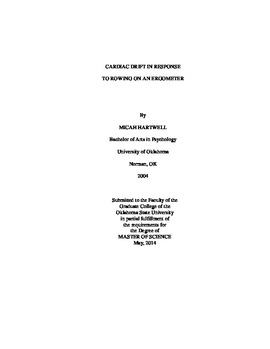| dc.contributor.advisor | Smith, Doug | |
| dc.contributor.author | Hartwell, Micah | |
| dc.date.accessioned | 2015-06-17T20:06:15Z | |
| dc.date.available | 2015-06-17T20:06:15Z | |
| dc.date.issued | 2014-05-01 | |
| dc.identifier.uri | https://hdl.handle.net/11244/14874 | |
| dc.description.abstract | In rowing, there are many physiological strains imposed upon the body unlike those in any other sport. The process of rowing powerfully contracts and expands the entire body at a controlled rate between 18 to 40 strokes per minute. Unique characteristics of the rowing stroke may influence heart rate variability over time. Cardiovascular drift is a gradual increase of HR during steady-state exercise at moderate intensity; research shows that this phenomenon occurs after approximately 15 minutes of exertion during running and cycling. Measuring HR variability and the occurrence of cardiac drift has yet to be analyzed during rowing on an ergometer. Methods. Two groups of 10 male collegiate rowers (n = 20) performed a 60-minute session on an ergometer wearing HR monitors. During the bout, perceived rate of exertion was also measured at three-minute intervals. Demographic variables, post-workout dehydration, and ambient room temperature were measured. Descriptive statistics, dependent and independent samples t-tests, Pearson's correlation coefficients, and linear regression were conducted to analyze variables. Results. Cardiovascular drift occurred without a stabilization period as seen in other endurance exercise. The gradual increase in HR began after the early onset of the acclimation phase, approximately three minutes into the session, unlike that observed during running and cycling. A significant positive association between mean RPE and mean HR was observed (r = .989, p < .01). Ambient room temperature and additional weekly minutes of aerobic exercise apart from team practice affected RPE at the 60 minute mark. A colder room temperature and increasing minutes of aerobic exercise were associated with a higher 60-minute RPE (R2 = .409). Conclusion. These findings may alter the current approach to adapting cycling and running HR training regimens to the sport of rowing and may even necessitate that rowing coaches develop their own training regimens when using HR as a monitoring mechanism. The early onset of cardiac drift suggests that target heart rate training zones may be unique for the sport of rowing. | |
| dc.format | application/pdf | |
| dc.language | en_US | |
| dc.publisher | Oklahoma State University | |
| dc.rights | Copyright is held by the author who has granted the Oklahoma State University Library the non-exclusive right to share this material in its institutional repository. Contact Digital Library Services at lib-dls@okstate.edu or 405-744-9161 for the permission policy on the use, reproduction or distribution of this material. | |
| dc.title | Cardiac Drift in Response to Rowing on an Ergometer | |
| dc.type | text | |
| dc.contributor.committeeMember | Volberding, Jennifer | |
| dc.contributor.committeeMember | Jacobson, Bert | |
| osu.filename | Hartwell_okstate_0664M_13275.pdf | |
| osu.accesstype | Open Access | |
| dc.description.department | Education (all programs) | |
| dc.type.genre | Thesis | |
| dc.subject.keywords | cardiac drift | |
| dc.subject.keywords | endurance | |
| dc.subject.keywords | ergometer | |
| dc.subject.keywords | heart rate | |
| dc.subject.keywords | rate of perceived exertion | |
| dc.subject.keywords | rowing | |
